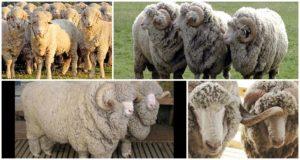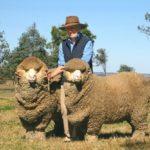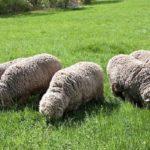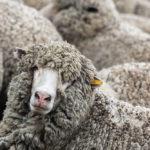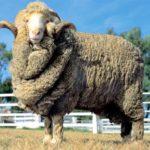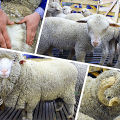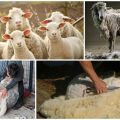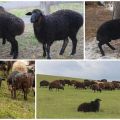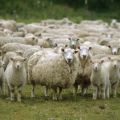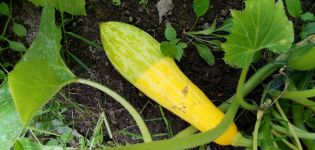Characteristics of merino sheep and who bred them, what is known and breeding
Merino sheep are rightly considered the best wool sheep. The merino sheep has the finest, soft-touch wool, widely used in the textile industry. The breed belongs to fine-fleece, the hairs of the animal are much thinner than a human hair, fit tightly to each other, forming a thick fleece. There are no difficulties in the care and maintenance of merino, and the products of sheep breeding, due to the demand, quickly pay off.
The origin of the breed
Merino is a breed created by selection in the 13th century in the Spanish kingdom. The breed was obtained as a result of crossing sheep brought from the Middle East and North Africa. Merinos were considered a national treasure; in the 18th century, the royal authorities imposed a strict ban on the export of valuable animals outside the state, and disobedience was punishable by death.
By the end of the 18th century, when the Spanish kingdom was weakened by the war with Britain, the ban was lifted. And immediately they began to transport the sheep to other countries. In every country, the merino has been visited with local breeds in order to obtain the best characteristics. So the breed acquired many varieties.
Nowadays there are the following varieties of merino:
- Australian - medium-sized sheep, are distinguished by high wooliness. One ram gives 10-12 kg of fleece.
- Electoral is a Spanish variety. The advantage of the breed is super-fine hairs, the disadvantage is the pickiness of the sheep to the conditions of detention.
- Negretti are German-bred sheep. The body is covered with folds, so productivity is higher. But the quality of the rune is not as high as that of the Australian counterparts.
- Rambouillet is a French variety. Animals are distinguished by long hair and good health.
- Mazayevskie merino sheep are hardy sheep adapted to the climatic conditions of our country. They were bred in the 19th century by the Russian breeder Mazayev. The disadvantage of the breed is a weak skeleton.
- The New Caucasian type of merino is the result of crossing the Mazayev and French sheep. Animals have strong immunity and soft to the touch wool.
- The Soviet type is the result of the mating of New Caucasian and French merino dogs. The variety is popular with the Volga, Ural, Siberian farmers.
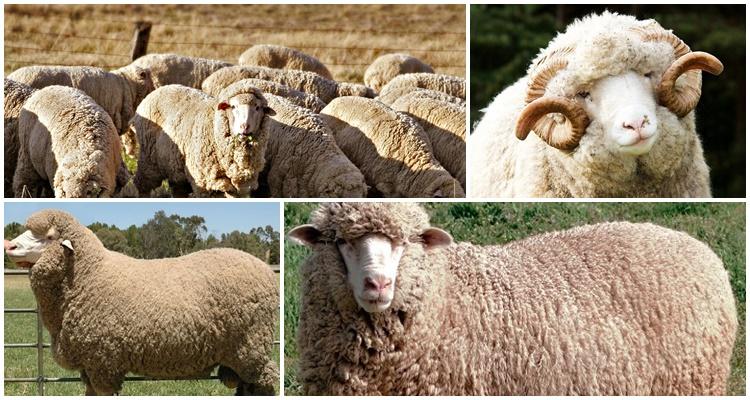
Characteristics and description of the breed
Merino is a sturdy animal with a strong skeleton, harmonious constitution, correct set of limbs. The head of the ram is decorated with spirally twisted, hollow horns inside. Some species have folds of skin on the neck and chest.
The merino wool is white, but the grease secreted makes it yellowish. The hairs are very thin (15-25 microns), in males they reach 8-9 cm in length, in females - 7.5-8.5 cm, densely adjacent to each other. The coat completely covers the body, only the muzzle is bare. For a year, 10-12 kg of fleece is received from the male (record - 28 kg), from the female - 6-7 kg (record - 9.5 kg).
Why merino wool is considered elite
Merino wool is expensive and one of the most demanded in the textile industry. It produces a delicate, warm-keeping yarn, pleasant to the touch. The villi of the fabric are curving, springy, so they do not retain dirt. And the substances contained in sheep wool act as antiseptics.
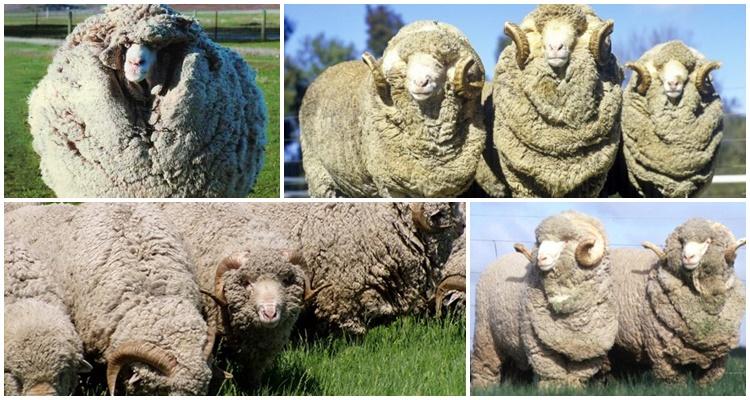
The production is almost waste-free. From 1 kg of wool, 1 kg of fiber is obtained. The softness of wool fibers is 3 times higher than silk, and elasticity is 5 times higher than cotton. Merino products are popular because:
- do not prick the skin;
- do not absorb sweat and odors;
- do not absorb moisture;
- let air through;
- do not cool the body in winter, do not make you sweat in summer;
- easy to wash;
- do not become a breeding ground for pathogenic microorganisms;
- do not cause an allergic reaction;
- easy to paint;
- serve for a long time without losing quality.
There are known cases of the positive effect of woolen products on human health, they relieve pain in rheumatism and radiculitis.
Advantages and disadvantages
Requirements for maintenance and care
Merinos are not capricious in their care and maintenance. A dry, ventilated room is used as a barn, warm in the winter months, not hot in the summer. There should be no drafts. You can leave the earthen floor, you can make clay or plank flooring. A corral is adjusted to the leeward wall of the building. In areas where the winter period is frosty, an insulated structure with a canopy is erected in the middle - a hothouse, where the temperature should be + 12 ° C.
Space norm for an adult ram - 2 m2, per female - 1.5 m2, for the uterus with a lamb - 2.5 m2, per calf - 0.8-1 m2.
Merinos are cut once a year, in spring. For a haircut, a platform with a side of 1.5 m is built, covered with a thick oilcloth. During the day before the procedure, the animals are kept on a hunger strike, they are not even allowed to drink, otherwise a haircut can lead to a rupture of the intestines. Do not cut wet wool, it must dry. When shearing, the sheep should not lie with their belly up. The wool is carefully removed with a whole fleece.
Merino sheep are bathed 2 times a year: 3 weeks after spring shearing and in summer. Choose a warm day for swimming. The sheep are chased along a 10-meter long dug trench with a gentle exit, filled with a disinfectant solution. The water level should not be higher than the neck of the animal. Some farms use shower units to disinfect sheep.

Sheep hooves are regularly cleaned, dirt accumulations are picked out from the depressions, the horny part is trimmed 4 times a year, trying not to touch the living tissue. Do not touch the hooves of the uterus in late pregnancy, they may have a miscarriage due to stress.
Sheep diet
In the spring months, sheep feed on grass, feed concentrates, hay, and salt stone is suitable as a source of minerals. You cannot give silage. In summer, the diet is similar, only the portion of the grass is increased, and the concentrated feed is reduced. In autumn, the sheep are given the remaining grass, hay, salt and vegetables are added to the diet. In winter, animals feed on hay, high-quality silage, mixed feed, vegetables and root crops, and lick a salt stone.
A lamb left without a mother is fed with cow or goat milk with vitamin supplements for up to 3 months.
The merino is grazed from spring to late autumn. The grazing rules are shown in the table.
| Spring | begins at the end of April, when the grass is over 8 cm, and the dew dries quickly from the morning sun, otherwise the wool will get wet, start to rot, and the sheep will catch cold |
| Summer | animals are driven out at dawn, from 11 am to 5 pm, the flock is kept in the shade, grazing continues until 22 pm |
| Autumn | sheep are grazed from 6 in the morning until noon, then sent under the shed, grazing continues from 16 in the evening until dusk |

Breeding features
For mating, timing is made so that the offspring is born in early spring, when there is no longer cold weather, and the grass is high enough. There are merino dogs that have reached 2 years of age. The couple is left in a fenced-in place for 2 days. If the coating does not happen, then the mating is repeated after half a month. To solve breeding problems, artificial insemination is practiced, lamb sperm is injected with a veterinary syringe into the female's vagina.
The uterus gives birth 20-22 weeks after fertilization. The presence of a veterinarian is desirable. Usually, childbirth in Merino is problem-free, but sometimes you have to break the amniotic sac with your hands and remove the baby. After 15-20 minutes, the lamb gets to its feet, looking for the mother's udder.
Frequent illnesses
Merino sheep are hardy and rarely get sick. They are sensitive only to dampness. If you keep them in a damp room, take them out on dewy grass, then colds are inevitable. In case of poor-quality care during the warm period, parasitic insects settle in the thick wool of the sheep, so farmers have to constantly carry out preventive and therapeutic measures: bath animals, use disinfectants.
The regrown hooves of sheep are prone to decay. Prevention - regular bedding change, barn cleaning. It is recommended to arrange a hoof bath with 15% salt solution for the sheep every week.
Merino farming business
Sheep breeding is a profitable occupation. Merino wool is worth decent, will always be in demand. In addition to wool, meat of young individuals can be sold, it is tasty and tender.
How much you can sell merino wool depends on the country where the manufacturer is located. The lowest prices in the CIS countries. In Australia and Western countries, where the purchasing power is higher, wool is expensive, it is considered selective. One 50-gram skein will cost $ 15, for a woolen blanket you will have to shell out from $ 50 to $ 250. But the price matches the quality.
